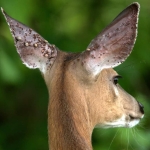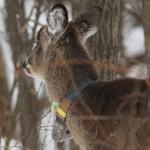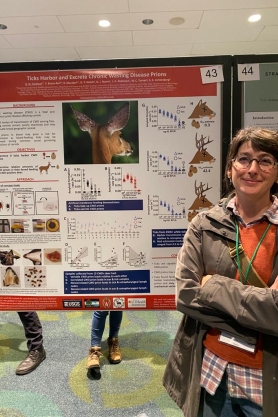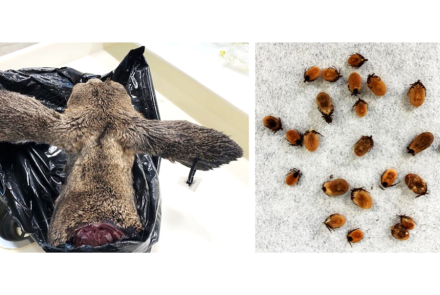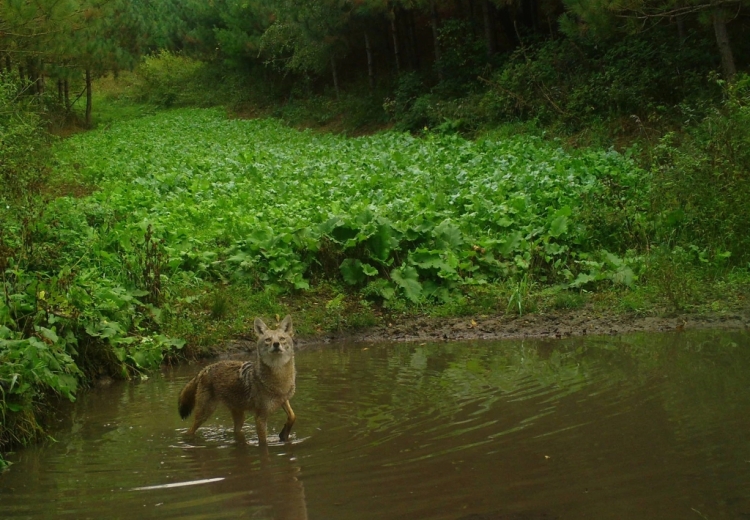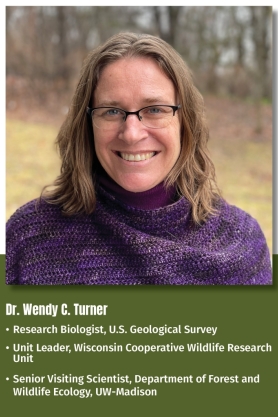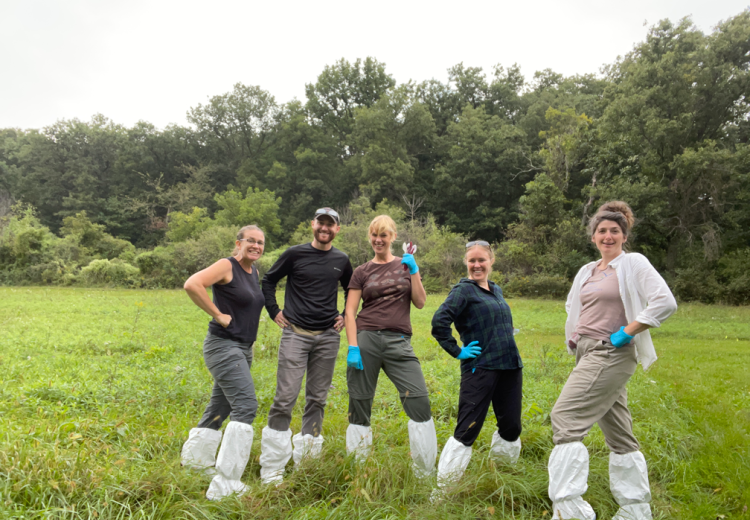July 2023 - Field Notes Newsletter
CWD is persistent in the environment, which begs the question: what are all the ways that deer can come in contact with CWD? UW-Madison researcher Dr. Heather N'te Inzalaco decided to think outside the box in her investigation into landscape and community-level factors of CWD transmission.
Inzalaco is a part of the UW-Madison lab that works on many SW CWD Study projects, led by Dr. Wendy Turner, who we introduce to you in this edition. Turner is a wildlife disease ecologist who is bringing her knowledge and experiences to Wisconsin from working with anthrax in southern Africa and facilitating many wildlife disease research projects. She talks about her ranching background, similarities between her anthrax work and CWD, and what it's like building the IPM.
A UW-Madison researcher is tackling the question of how CWD spreads across the landscape, down to the smallest detail.
COLLABORATOR HIGHLIGHT: DR. WENDY TURNER
The SW CWD Study is possible because of strong collaborations. Meet Dr. Wendy Turner, who is our collaborator from UW-Madison Department of Forest and Wildlife Ecology and the Wisconsin Cooperative Wildlife Research Unit.
Thinking Outside the Box: Investigating The Roles Of Ticks And Predators As Environmental Factors of CWD
There’s a lot we don’t know about chronic wasting disease (CWD), especially all the ways deer can acquire it. We know prions can be directly transmitted between deer and that they can persist in the environment, infecting more deer. Beyond that, our understanding gets murky. However, the details matter because they determine how CWD epidemics will unfold and what management actions might be effective. That’s where Dr. Heather N’te Inzalaco, who started her CWD research in 2020, steps in.
Inzalaco is a post-doc student at UW-Madison, working with Dr. Wendy Turner, the unit leader for the USGS Wisconsin Cooperative Wildlife Research Unit. Inzalaco has experience working with CWD and scrapie (another prion disease that affects sheep and goats) from working in the prion research lab at the USGS National Wildlife Health Center. Prior to working with Dr. Turner, she was part of the late Dr. Joel Pedersen’s lab when he was at UW-Madison working on a DNR funded research project developing methods to detect CWD prions in soil, using a newer protein amplification assay called the real-time quaking-induced conversion (RT-QuIC) assay.
“I carved research projects out for myself,” Inzalaco said of her start in Dr. Pedersen’s lab. “I felt it was important to consider host behavior interactions with environmental factors that I felt had been overlooked previously with CWD and how those fit into CWD dynamics.”
Inzalaco said there are most likely many environmental factors that could be contributing to the spread of CWD and prevalence increases of the disease. “CWD is a disease system that is extremely complex. It likely has a large environmental component, and these landscape- and community-level factors need more focus on them,” she said. Inzalaco decided to investigate two potential environmental sources of CWD transmission: ticks and predators.
First Steps: Detecting Prions
One of the first steps to understanding the potential roles of these environmental components is determining if they contain prions. Inzalaco is determining if these kinds of environmental variables have prions present and if the amounts of prions they harbor are enough to cause disease transmission.
To detect prions in these “weird sample types,” Inzalaco used the real-time quaking-induced conversion assay (RT-QuIC), a fluorescence-based assay that can detect prions in samples containing very low prion levels; the same assay researched in the Pedersen lab. “RT-QuIC is very sensitive to ultra-low levels of prions and is a relatively quick assay compared to other diagnostic assays. It’s also more financially manageable than some other CWD diagnostic methods,” said Inzalaco.
RT-QuIC exploits the ability of misfolded prions to self-replicate by placing a sample that possibly contains infectious (misfolded) prions with a sample of normal prions. If there are misfolded prions in the test sample, they convert the normal prions and then aggregate to form prion clumps called amyloids. A fluorescent dye clings to these amyloids and will glow to reveal the relative levels of infectious prions in the sample. The intensity of the fluorescence and the time it takes for the fluorescence to reach that intensity gives researchers a way to measure relative concentrations of misfolded prions within the sample.
This ability and the assay’s extreme sensitivity is what sets RT-QuIC apart from other CWD-testing methods. It also allows for earlier detection of CWD prions in a sample, possibly opening doors to less invasive methods of CWD testing.
Ticks
Inzalaco realized that one of the most common social behaviors among deer, allogrooming, could be facilitating CWD exposure and transmission. Allogrooming is where deer groom each other to help remove ectoparasites, especially from hard-to-reach areas like the back of the neck and ears. While deer can transmit CWD directly through saliva during these grooming sessions, Inzalaco zeroed in on the purpose for deer to groom each other: to remove ticks.
During allogrooming, deer can consume the ticks and tick blood meals. Blood from a deer with CWD contains infectious prions and naturally ticks ingest a lot of blood. “That’s what is concerning - how much blood [the ticks] take up and how long they stay attached. Couple that with white-tailed deer’s grooming of one another, and you have two important factors that we need to consider. Ticks may be a mechanical vector for transmission of CWD,” said Inzalaco.
Inzalaco first needed to find out if ticks can take in prions from blood and if so, can it be detected by RT-QuIC. She used artificial membrane-feeding assays made from silicon membranes to feed prion-loaded blood to black-legged ticks (also known as deer ticks) and then tested those tick samples using RT-QuIC. Inzalaco found that not only is RT-QuIC compatible for detecting prions in tick samples, but that ticks do harbor and excrete prions.
Armed with this proof-of-concept that ticks can assimilate prions from a blood meal, Inzalaco moved onto the next step. She headed over to the DNR’s CWD processing facility to collect black-legged ticks from hunter-harvested deer heads submitted for CWD testing. Inzalaco examined over 2,000 deer heads and collected ticks from 175 of them. She focused on collecting ticks that were still attached and had been feeding so they had a blood meal. Of the 175 deer heads Inzalaco collected ticks from, 15 were CWD positive. Inzalaco analyzed the ticks collected from those 15 deer to determine if the ticks had taken in CWD prions from those deer.
Three of the CWD-positive deer heads also contained CWD-positive ticks with transmission-relevant levels of CWD prions. “This study shows that blood is important when we consider the implications of social grooming behavior among deer, suggesting that ticks could play a role in transmission,” said Inzalaco. Inzalaco’s findings on ticks were recently published in the journal Scientific Reports; read the full paper here [exit DNR]. Now that it is shown that ticks can harbor CWD prions, the next steps for this research will be to determine how often deer consume ticks and if consumption of infected ticks will lead to disease.
Predator Scat
Inzalaco then turned her attention to another understudied aspect of the environment and CWD: predators. The tissue of CWD-infected deer (including muscle, skin and internal organs) is eaten by carnivores or scavengers at carcass sites, so it makes sense that they must play some role in the distribution of prions in the environment. “We don’t know enough about how predators influence the bioavailability of prions. Do they help reduce the amount of CWD prion contamination on the landscape? Do they mitigate the risk by consuming diseased animals?” said Inzalaco. It is also possible that they could spread CWD prions in the environment when dragging diseased parts from carcass sites, or defecating elsewhere, spreading prions to new places.
Like when she studied ticks, Inzalaco first had to determine if prions could be detected by RT-QuIC from different carnivore and scavenger scat samples and develop the best protocols for each species sample. She started with spiking assays, taking scat of nine different species (wolves, coyote, crow, raven, eagle, black bear, cougar, raccoon, and red fox) from areas with no CWD detections and spiking the samples with known levels of CWD material. Some of these negative controls (wolf, coyote, raven, cougar, and red fox) were collected in the Greater Yellowstone ecosystem in 2020, which did not have any CWD detections at the time of collection, while the rest came from wildlife rehabilitation centers.
“I worked with dried feces. Then I take CWD-positive material, usually brain from a deer in the late stages of CWD, which I also test using RT-QuIC beforehand, and make multiple dilutions of that brain sample that I then mix with each scat sample. Then I process the spiked scat samples and enrich them to help recover any prions I put in and use RT-QuIC to test those processed and enriched samples,” said Inzalaco. RT-QuIC was able to detect CWD prions in all the spiked predator scat samples, showing that Inzalaco’s methods were ready to be tested in the field.
Inzalaco applied these protocols when analyzing seven different coyote scat samples collected near mortality sites of deer collared by the Southwest Wisconsin CWD, Deer and Predator Study. Six of the seven deer mortalities were CWD-positive. Inzalaco tested viable tissue from each deer for a relative measure of concentration of CWD prions to compare to the amounts in the coyote scat. Predators will use scat to mark the area around carcasses they are feeding on, so it is likely that the scat came from the same individual coyotes that were feeding on the deer.
Using RT-QuIC, Inzalaco was successfully able to detect prions in the coyote scat collected at the mortality sites, setting the stage for further investigation into the role predators play in CWD dynamics. “We have empirical evidence to see that predators are involved, and now we have a way to evaluate it,” she said. Because of Inzalaco’s work, RT-QuIC can be used to test for CWD in many different scat samples, which could lead to earlier, non-invasive surveillance of CWD in areas where monitoring is low or inconsistent.
Opening the Door
Inzalaco’s work made possible new avenues of investigating CWD transmission, and she has begun to shed light on several potentially important pieces of the CWD dynamics puzzle.
“We can use the RT-QuIC assay to test new sample types, which could be quite useful. It allows us a glimpse at ecologically- and management-relevant, community-level factors that might be influencing why prevalence of CWD is still increasing, [despite control efforts],” said Inzalaco.
Currently, Inzalaco is studying how soil can influence environmental transmission of CWD, using the RT-QuIC assay to test soil samples taken from mineral lick and baiting sites in Wisconsin and Tennessee. Combining the soil analyses with camera trap images to monitor deer behavior, Inzalaco is investigating how prion loads accumulate in soil over time and how deer behaviors when visiting a site might contribute. She will also be working on a project that aims to better understand prion deposits in soil at carcass sites and how scavengers influence those deposit distributions.
There is still a lot more to learn about how CWD spreads through a landscape, but now Inzalaco has thrown open the door and is walking through. “We have preliminary data, but we need to do more,” she said. Inzalaco is excited to continue working with the DNR and Dr. Wendy Turner’s lab at UW-Madison to advance her research, further evaluating how ticks, scat and soil influence CWD dynamics. The small details matter—and Inzalaco’s work will help us better understand, and hopefully better manage, chronic wasting disease.
Collaborator Highlight: Dr. Wendy Turner
WHAT IS YOUR ROLE IN THE SW CWD STUDY?
Turner is a wildlife disease ecologist who joined the SW CWD Study in July of 2020, at the end of the field work phase for the project and the beginning of the data analysis phase. “My role has really been to support the DNR working with these datasets and facilitate between projects,” said Turner.
Turner, in conjunction with DNR Deer Research Scientist Dr. Dan Storm, works with students and postdocs in her lab at UW-Madison on many CWD projects. Some of the folks in Turner’s lab we have introduced before in this newsletter. Dr. Alison Ketz is the lead scientist building the IPM for the SW CWD Study. Dr. Marie Gilbertson has made an appearance in the past couple of Field Notes newsletters, sharing her findings for the SW CWD Study on juvenile dispersal, adult deer necropsies and how those may affect CWD distribution. Dr. Heather Inzalaco, introduced in this edition on her tick and predator research, is currently studying deer carcass sites, scavengers and CWD transmission.
Many others in Turner’s lab are also working on CWD projects such as:
- Buck movement ecology during rut
- Transmission risk at deer scrapes and food plots
- Deer behavior and transmission risk from video camera collar data
- Predator movement and CWD
“The main theme running through all these projects is to understand the role of environmental variation, host ecology and behavior, and pathogen distribution patterns in the risk of CWD transmission,” said Turner.
HOW WILL YOUR BACKGROUND HELP STUDYING CWD?
Turner feels that her prior role as an assistant professor at the University at Albany, State University of New York prepared her well for the SW CWD Study. “I had a big project working on anthrax in southern Africa where we had field teams in two countries, collaborators from all over the planet, and a whole bunch of grad students conducting projects. I feel very confident in facilitating research and making sure things are getting done,” said Turner. She found that whether studying disease systems in southern Africa or in Southwest Wisconsin, similar questions were being asked.
“What is really interesting about these wildlife disease systems is working with pathogens that have really persistent environmental forms, so they don’t need to be inside the hosts to be a part of the disease system,” said Turner. Then, she continued, the interesting questions become:
- Is the pathogen survival the same in different habitats or environments?
- How do animals encounter the pathogen and what is in the environment?
- What behaviors, what environmental conditions change contact with a pathogen?
- Who is most likely at risk—males, females, young, adults?
Those questions sound familiar, right? While the system is different, the questions and approaches to research can be similar, Turner said. She enjoys seeing the collaboration between members of her lab working on anthrax in Africa and CWD in Wisconsin, and how the two projects can help each other. “You might not know anything about zebras, or deer, but you know a lot about the challenges of trying to deal with pathogen contact and how to approach [studying] it,” said Turner.
In addition to her experiences as a wildlife disease ecologist, Turner’s Wyoming ranching roots brings in a different perspective to her work. Working with the DNR to answer these CWD questions in Wisconsin often means working with private landowners to access study areas. In Wyoming, Turner was the private landowner that state or federal scientists would sometimes need to work with conducting research projects. “It gives me a different perspective on things. I remind our team that the relationships with our landowners are so important, we can’t do any of the work that we do without them,” she said.
WHAT INTERESTS YOU THE MOST ABOUT THE SW CWD STUDY?
“I can’t think of a different location or a system that has monitored this disease as long or as well as the [DNR] has in the Southwest Wisconsin ecosystem, just the size of the datasets, how many animals have been sampled each year, the number of GPS collars out there…There’s nothing like that out there,” said Turner.
The chance to work with these datasets is what attracted Turner to the project, as someone who knows very well the hard work and effort that goes into collecting that much data. This collaboration, Turner said, also means being able to accomplish more together. “Being able to leverage that effort to ask more complex questions means there’s a lot more that we can answer,” she said.
WHAT DOES BUILDING THE IPM LOOK LIKE?
“It is a very ambitious project,” said Turner. “Alison Ketz is working hard on it. It’s a complex model to put together.” Dr. Alison Ketz is an ecological statistician and quantitative ecologist in Turner’s lab who took on the challenge of building this unique model.
There are a lot of moving parts in the IPM, bringing together all those datasets that attracted Turner to the study. Adult and fawn survival, CWD surveillance data, and taking in consideration what is happening spatially and over time. That’s hundreds of thousands of data points for Ketz to consider and run through the model. When running continuously, Turner said, the model can take more than a month to complete. “I think it’s really hard to fathom,” said Turner. The model is more than 18,000 lines of code and if something doesn’t add up, that’s 18,000 lines of code to comb through to find the issue.
But there’s more to creating and running this model than just knowing and going through code, Turner said. “It’s quite technical and requires a lot of specialized skills. You have to understand the disease. You have to understand the program. You have to understand how an IPM works and what you’re trying to do,” she said. Turner is excited that recently another expert with the required skills, DNR Research Scientist Glenn Stauffer, joined Ketz to help review the code.
The IPM is in the troubleshooting stage, said Turner. “It’s an awful lot of checking to make sure everything is working the way it’s meant to be, we want to make sure when we’re giving a result, that it’s an accurate result,” said Turner.


